Introduction to Persian Recipes 📖
Persian recipes have always held a special place in my heart. Growing up in a multicultural neighborhood, one of my best friends was Iranian. Every Nowruz, her family would invite me over, and I’d be mesmerized by the vibrant spreads, the aroma of saffron rice, and the gentle hospitality that defined each meal. That first bite of khoresh fesenjan, sweet and tangy with walnuts and pomegranate, hooked me for life. Since then, I’ve been exploring and recreating the timeless beauty of Persian cuisine in my own kitchen.
If you’re here, you’re likely curious—or perhaps already enchanted—by the elegance, richness, and depth of traditional Iranian cooking. And trust me, you’re in the right place.
🌿 What Makes Persian Cuisine So Special?
- A delicate balance between sweet and savory flavors
- Heavy use of herbs, spices, and fruits like saffron, dried limes, and pomegranate
- Deeply rooted in history, tracing back to the Persian Empire
- Rich culinary traditions linked to celebrations, especially Nowruz (Persian New Year)
🥘 Foundations of Persian Cooking
- Signature dishes like chelow (plain rice), khoresht (stews), and kebabs
- Accompaniments such as yogurt dips, fresh herb platters, and flatbreads
- Unique cooking techniques like dam pokhtan (slow-steaming rice)
Whether you’re here to cook your first Persian dish or to elevate your skills with authentic Persian recipes, this guide will take you through every essential—from the pantry to the plate.
Table of Contents
Essential Ingredients in Persian Cooking 🧂
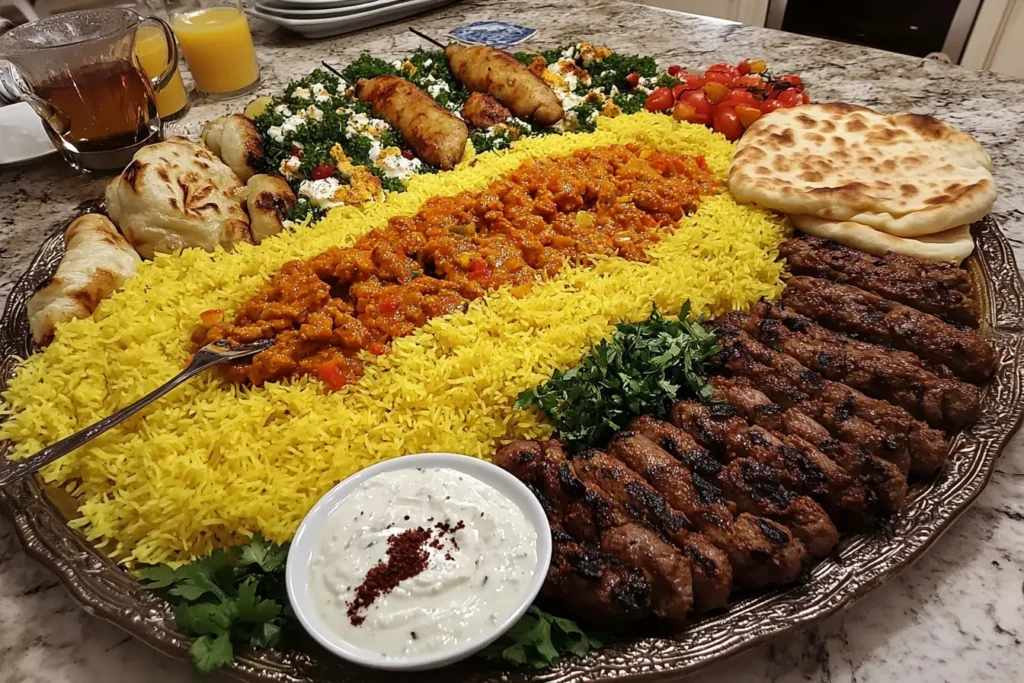
You can’t create authentic Persian recipes without understanding the soul of the cuisine—its ingredients. In Persian recipes cooking, every component is chosen not just for flavor, but for balance, color, aroma, and often, symbolism. These are not just pantry staples—they’re cultural touchstones passed down through generations.
Whether you’re recreating sabzi polo or crafting a simple mast o khiar, these core ingredients will help bring genuine Iranian flavors to life.
🌸 Herbs and Aromatics
Fresh herbs are at the heart of many Persian recipes, often used in large quantities:
- Parsley, cilantro, dill, and fenugreek for stews like ghormeh sabzi
- Mint and tarragon in cold dishes and dips
- Green onions and chives in herb platters (sabzi khordan)
🔥 Signature Spices
Persian cuisine uses spices with a light hand, creating subtle but complex flavors:
- Saffron: The most prized spice in Iran, used in rice, desserts, and tea
- Turmeric: Adds warmth and color to almost every stew (khoresh)
- Cinnamon, cardamom, and clove in desserts and festive rice
- Dried limes (limoo amani): A tangy, fragrant essential in stews
🍚 Rice – The Crown Jewel
Rice isn’t just a side in Persian cuisine—it’s a masterpiece:
- Basmati or long-grain Persian rice
- Techniques like soaking, steaming, and creating tahdig (crispy crust)
- Used in dishes like zereshk polo, sabzi polo, adas polo, and baghali polo
🍗 Proteins and Legumes
Iranian meals balance meat, grains, and legumes:
- Lamb and chicken are most common
- Beef is often used for kebabs
- Yellow split peas, chickpeas, and lentils in stews and soups like ash reshteh
🥣 Sour and Sweet Balancers
Flavors in Persian recipes often play between tart and sweet:
- Pomegranate molasses for depth and acidity
- Barberries (zereshk) in rice dishes
- Dried apricots, raisins, and dates in stews and pilafs
- Rosewater for desserts and drinks
Mastering these ingredients is the first step to preparing authentic, vibrant Persian recipes. Keep them stocked and fresh, and you’re already halfway to Iran—culinarily speaking.
Persian Cooking Techniques 🍳
Print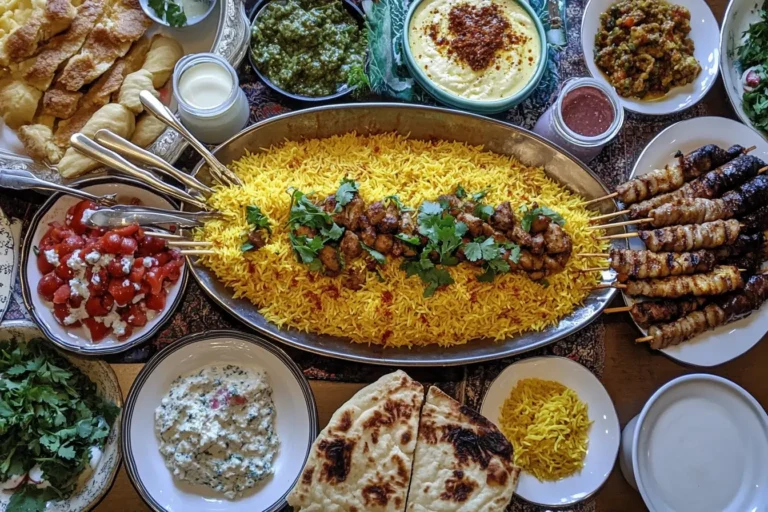
Persian Recipes: Sabzi Polo ba Mahi recipe
A collection of classic Persian recipes that bring the rich flavors of Iran to your kitchen. From crispy tahdig to fragrant stews and floral desserts, this guide covers everything for beginners and seasoned cooks alike.
- Total Time: 1 hour 5 minutes
- Yield: 4 servings 1x
Ingredients
- 2 cups basmati rice
- 1 cup fresh dill
- ½ cup parsley
- ½ cup cilantro
- 2 tbsp dried fenugreek
- 2 fillets of white fish
- 1 pinch saffron
- Salt and oil
Instructions
-
Soak rice in salted water for 1 hour, rinse, and parboil.
-
Mix herbs and layer with rice for steaming.
-
Steam with saffron water and form a crust (tahdig).
-
Season and pan-fry the fish until golden.
-
Serve hot with lemon wedges and pickled vegetables.
Notes
-
Use a nonstick pot for perfect tahdig.
-
Saffron water enhances aroma and presentation.
-
Can be served with mast o khiar or doogh.
- Prep Time: 20 minutes
- Cook Time: 45 minutes
- Category: Main Course
- Method: Steaming, Pan-Frying
- Cuisine: Persian, Middle Eastern
- Diet: Gluten Free
Nutrition
- Serving Size: 1 plate
- Calories: 510 kcal
- Sugar: 2g
- Sodium: 240mg
- Fat: 15g
- Saturated Fat: 3g
- Unsaturated Fat: 10g
- Trans Fat: 0g
- Carbohydrates: 65g
- Fiber: 5g
- Protein: 28g
- Cholesterol: 50mg
Keywords: persian recipes, iranian food, tahdig, sabzi polo, khoresh, iranian cuisine, saffron rice, middle eastern food, persian dinner, traditional iranian food, fesenjan, ash reshteh, persian dessert, barberry rice, nowruz recipes, persian vegetarian, iranian stews
If ingredients are the language of Persian recipes, then cooking techniques are the grammar. Understanding Persian cooking techniques will help you unlock the textures, aromas, and layers that define this cuisine.
Persian food is never rushed—it’s patient, detailed, and built on generations of culinary tradition. Let’s explore the core techniques that make Persian dishes taste like home.
🔥 Dam Pokhtan – The Art of Steaming RiceArguably the most iconic method in Persian cuisine, dam pokhtan ensures that rice is fluffy, aromatic, and perfectly layered.
- Soak basmati rice to remove starch
- Parboil until almost tender
- Drain and layer with oil, butter, or yogurt
- Steam gently with a towel-lined lid to trap moisture
- Always finish with tahdig—the crispy, golden rice crust at the bottom
🥘 Slow Simmering for Stews (Khoresht)
Stews or khoresht are the backbone of many Persian recipes and are characterized by depth and balance.
- Brown onions and proteins first to build flavor
- Add spices like turmeric and cinnamon early
- Let simmer on low heat for 1–2 hours
- Use minimal water to concentrate flavor
- Finish with acidic or sweet notes (like dried lime or pomegranate molasses)
🍖 Searing Meat for Kababs and Stews
Even in stews, meats are seared before simmering:
- Sear lamb, chicken, or beef to lock in juices
- Often marinated in saffron, yogurt, or citrus
- For kababs, meat is skewered and grilled or pan-seared (Kabab Tabei)
🧄 Layering and Building Flavor
Persian recipes cooking relies on patient layering of ingredients, especially in rice and stews:
- Rice is often layered with herbs, meat, or beans (e.g., adas polo)
- Stews are built from aromatics → meat → spices → slow simmering
- Finishing touches include rosewater, lime juice, or barberries
🍲 Balancing Texture and Color
Visually stunning, Persian recipes also pay attention to contrast:
- Crisp tahdig vs. soft rice
- Fresh herbs with heavy stews
- Golden saffron rice next to dark fesenjan
- Garnishing with nuts, seeds, or dried fruits
These techniques are the heartbeat of Persian cuisine. Once you master them, you’ll be able to recreate even the most elaborate Persian dishes with confidence and authenticity.
Must-Have Persian Kitchen Tools 🧰
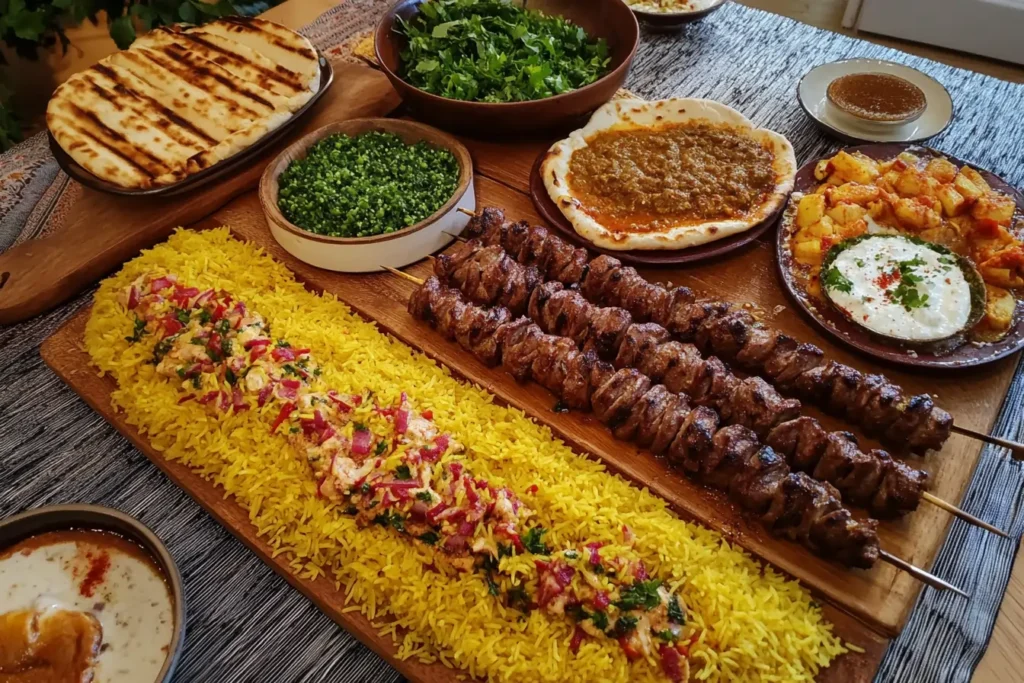
When diving into Persian recipes, it helps to equip your kitchen with tools that make the cooking process smoother and more authentic. While you can prepare many dishes with standard cookware, having a few traditional Persian tools can elevate your results—especially when it comes to making perfect tahdig or aromatic herb-rich stews.Here are the most essential tools for anyone passionate about mastering Persian cuisine.
🍚 Rice Pot (with a Dome Lid or Damkoni)
- The holy grail of Persian cooking is perfectly steamed rice with tahdig.
- A deep nonstick pot or Persian rice cooker ensures even heat and crisp crusts.
- A damkoni (fabric lid cover) helps trap steam, making rice fluffy and flavorful.
🔪 Sharp Chef’s Knife
- Fresh herbs are key to many Persian dishes, so you’ll need a quality knife to finely chop them.
- Also essential for slicing meats for kababs and dicing onions for khoresht.
🥄 Mortar and Pestle or Spice Grinder
- Freshly ground saffron, cumin, or cardamom elevate every recipe.
- A small mortar and pestle lets you grind spices and crush saffron with sugar (a classic technique).
🍳 Wide Nonstick Skillet or Flat Pan
- For dishes like Kabab Tabei (pan-fried kebab), you’ll need a wide pan with even heat.
- Ideal for sautéing onions and browning meat in Persian stews.
Persian Tea Set (Samovar + Teapot)
- Tea is more than a beverage—it’s a Persian cultural ritual.
- A samovar keeps water hot while the concentrated tea (chai) brews in a small pot above.
🥗 Mixing Bowls & Strainers
- Many dishes require mixing yogurt dips, soaking rice, or draining herbs.
- Stainless steel or ceramic bowls help maintain flavors without absorbing aromas.
Having the right tools makes traditional Persian recipes not only easier to execute but more enjoyable. These aren’t just kitchen items—they’re bridges to cultural authenticity.
Popular Persian Appetizers & Dips 🥗
One of the most charming aspects of Persian recipes is how meals begin—with colorful, herbaceous, and creamy appetizers and dips. These small plates aren’t just starters; they set the tone for the entire meal, emphasizing freshness, balance, and hospitality.
Whether served during a family dinner or as part of a festive Nowruz spread, these appetizers are packed with character.
🥒 Mast o Khiar (Yogurt & Cucumber Dip)
A staple in nearly every Iranian household:
- Made with strained yogurt, finely chopped cucumber, dried mint, and salt
- Often includes raisins and walnuts for contrast
- Served cold with flatbread or alongside rice dishes
- Cooling, refreshing, and packed with probiotic benefits
🌿 Borani (Herbed Yogurt Dips)
A family of dips mixing vegetables and yogurt:
- Borani Esfanaj: Sautéed spinach with garlic and yogurt
- Borani Bademjan: Smoked eggplant blended with labneh or yogurt
- Borani Laboo: Beetroot yogurt dip with sweet and tangy notes
- Excellent as a side or spread
🧊 Ab Doogh Khiar (Cold Yogurt Soup)
A summer classic in Persian recipes cuisine:
- Made with cold yogurt, cucumber, walnuts, raisins, and mint
- Often includes dried rose petals for fragrance
- Served cold like a drink or soup—both nourishing and hydrating
🧀 Noon o Panir o Sabzi (Bread, Cheese, and Herb Platter)
A simple but iconic combination:
- Includes lavash or sangak bread, feta-style cheese, and fresh herbs
- Common herbs: basil, mint, cilantro, green onions
- Sometimes served with walnuts and radishes
- Perfect as a light start or breakfast dish
🍆 Mirza Ghasemi (Eggplant and Tomato Dip)
From Northern Iran, this smoky, savory dip includes:
- Roasted eggplant, garlic, tomatoes, and eggs
- Cooked in olive oil until it becomes rich and thick
- Best served warm with flatbread
These Persian recipes appetizers and dips don’t just awaken the palate—they reflect the Iranian philosophy of balance, freshness, and gathering. They’re easy to prepare yet incredibly diverse, making them a favorite entry point for new cooks exploring Persian recipes.
Persian Soups & Stews (Khoresht) 🍲
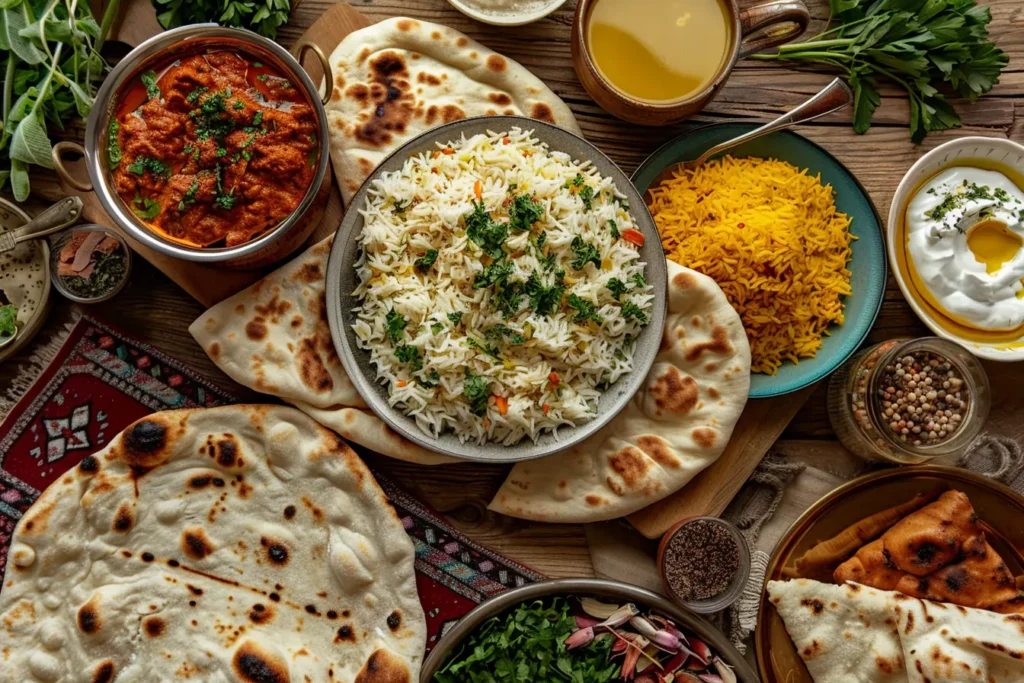
When people think of hearty, home-cooked Persian recipes, soups and stews immediately come to mind. Known as ash (soups) and khoresht (stews), these dishes are slow-cooked, richly spiced, and deeply comforting—often passed down for generations.
They represent the soul of Persian cooking, balancing herbs, spices, and textures into unforgettable meals typically served over chelow (plain rice).
🍜 Ash Reshteh (Herb and Noodle Soup)
A nourishing vegetarian soup perfect for winter and Nowruz:
- Loaded with herbs (parsley, cilantro, spinach), lentils, beans, and noodles
- Topped with kashk (fermented whey) and caramelized onions
- Tangy, hearty, and rich in protein
- Often enjoyed as a full meal
🥩 Abgoosht (Persian Lamb Stew)
A rustic and traditional dish with layers of texture:
- Made with lamb shanks, chickpeas, potatoes, and tomatoes
- Simmered slowly, then strained—the solids are mashed into a side dish (goosht koobideh)
- The broth is sipped like a soup
- Served with fresh herbs, onions, and flatbread
🌿 Khoresh Ghormeh Sabzi (Herb Stew)
Often called the “king of khoreshts” in Persian recipes cuisine:
- Made with parsley, cilantro, fenugreek, kidney beans, and beef or lamb
- Flavored with dried limes (limoo amani) for a citrusy punch
- Simmered for hours until the herbs turn dark green
- Served with steamed basmati rice
🍯 Khoresh Fesenjan (Walnut & Pomegranate Stew)
A luxurious and unique dish, sweet-savory in flavor:
- Ground walnuts simmered with pomegranate molasses and chicken or duck
- Rich, thick, and glossy—almost sauce-like
- Deeply flavored and perfect for holidays
- Often paired with chelow and turmeric pickles
🍆 Khoresh Bademjan (Eggplant Stew)
A classic Persian recipes dish that’s flavorful and aromatic:
- Fried eggplant, tomatoes, and lamb or beef
- Slow-cooked until tender, seasoned with saffron and lime
- Served over saffron rice for maximum comfort
- Can be made vegetarian with chickpeas
✅ Key Stew Tips in Persian Cooking
- Always start with caramelized onions for depth
- Simmer low and slow for optimal flavor
- Add dried limes, cinnamon, or turmeric toward the beginning
- Use plum, apricot, or quince for a fruity twist in some regional variants
These Persian stews and soups are more than meals—they’re cultural rituals. They turn simple ingredients into dishes with extraordinary depth, perfect for long family dinners or festive gatherings.
Classic Persian Rice Dishes
In Persian recipes cuisine, rice is more than a side—it’s a statement. From fluffy chelow to elaborate polo layered with meat, vegetables, and nuts, these Persian rice recipes showcase technique, elegance, and balance in every grain.
Tahdig (Crispy Rice Crust)
- The crown jewel of Persian rice
- Formed at the bottom of the pot, golden and crunchy
- Made with oil, butter, yogurt, or even lavash bread
- Universally loved and often fought over at the dinner table
Zereshk Polo (Barberry Rice)
- Made with barberries, lightly sautéed with sugar and butter for tart-sweet flavor
- Served with saffron rice and often paired with saffron chicken
- Perfect for festive occasions and family dinners
Sabzi Polo ba Mahi (Herb Rice with Fish)
- A Nowruz essential
- Mixed with dill, parsley, cilantro, and fenugreek
- Served with fried or grilled white fish
- Symbolizes rebirth and prosperity
Baghali Polo (Dill and Fava Bean Rice)
- Flavored with fresh dill and lima or fava beans
- Often layered with lamb shanks or chicken
- Light yet deeply aromatic, especially with saffron on top
Adas Polo (Lentil Rice)
- Made with brown lentils, raisins, and caramelized onions
- Can be sweetened with dates or spiced with cinnamon
- Typically served with ground lamb, meatballs, or chicken
Tips for Perfect Persian Rice
- Always rinse rice until the water runs clear to remove starch
- Use parboiling followed by gentle steaming (dam pokhtan)
- For authentic results, use a nonstick pot or Persian rice cooker
- Don’t rush the tahdig—low heat and patience yield the best crunch
Rice is at the heart of most Persian recipes, and mastering it brings you closer to the essence of Iranian culinary art.
Iconic Persian Meat Dishes
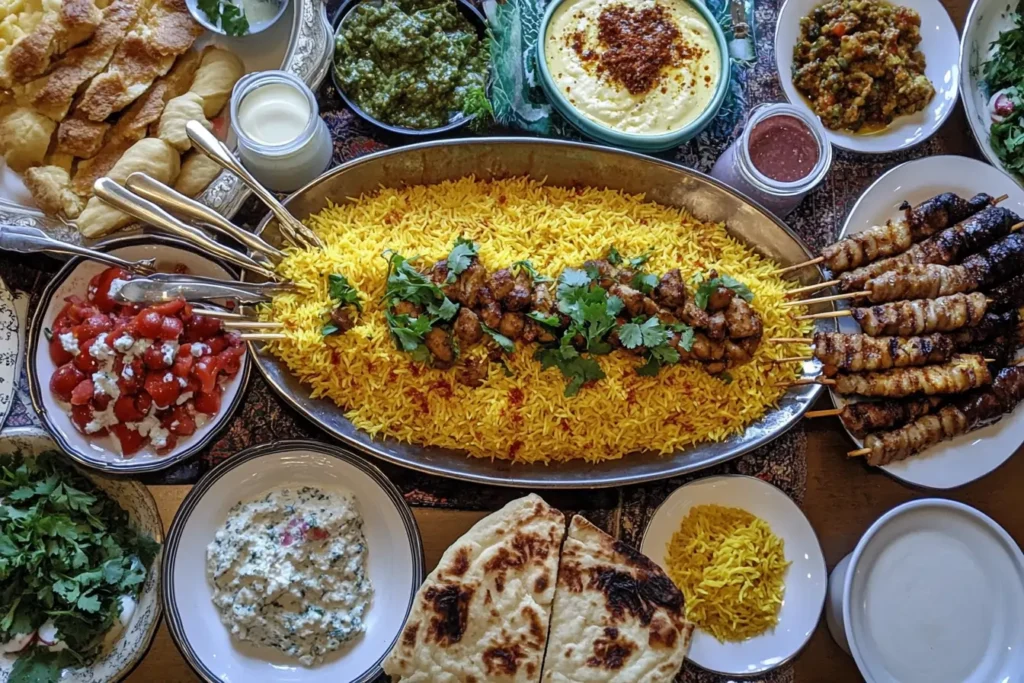
Meat in Persian recipes is used with care—always balanced with herbs, rice, or fruit. Whether grilled over charcoal or simmered in spiced stews, Persian recipes meat dishes are deeply flavorful and beautifully aromatic.
Kabab Koobideh (Ground Meat Kebab)
- Made with ground beef or lamb, grated onion, and spices
- Shaped onto flat skewers and grilled
- Served with chelow, grilled tomatoes, and sumac
- Simple, juicy, and one of the most popular kebabs in Iran
Kabab Barg (Filet Kebab)
- Thinly sliced beef tenderloin or lamb marinated in onion, saffron, and olive oil
- Grilled to a tender, smoky finish
- Often paired with buttery basmati rice and raw onion slices
Joojeh Kabab (Saffron Chicken Kebab)
- Chicken thighs or breasts marinated in saffron, lemon juice, and yogurt
- Grilled or roasted until juicy and golden
- Served at celebrations, often with Zereshk Polo
Kabab Tabei (Pan-Fried Kebab)
- A stovetop version of Koobideh
- Formed and flattened in a pan, then cooked until browned
- Ideal for weeknights—no grill required
- Often served with tomato paste rice or fresh flatbread
Khoresh Gheimeh (Yellow Split Pea Stew with Meat)
- Diced lamb or beef, onions, yellow split peas, and dried lime
- Simmered in tomato sauce and topped with crispy fried potatoes
- Comforting and a favorite at family gatherings
Tips for Cooking Persian recipes Meats
- Use saffron water for tenderizing and color
- Marinate meat for several hours or overnight
- Combine savory meats with sweet fruits like apricot or raisin in stews
- Always serve with herb platters, pickles, or yogurt dips to balance richness
These Persian recipes meat recipes blend tradition with technique—each bite full of culture and culinary depth.
Persian Vegetarian & Vegan Options 🥦
While many traditional Persian recipes include meat, Iran’s rich culinary heritage also offers an abundance of vegetarian and even vegan-friendly dishes. Thanks to the emphasis on herbs, beans, grains, and vegetables, plant-based eaters can enjoy Persian recipes food without sacrificing authenticity.
Kuku Sabzi (Herb Frittata)
- A deeply green, herb-packed frittata made with parsley, cilantro, dill, and leeks
- Traditionally includes eggs and sometimes walnuts or barberries
- Can be made vegan using flaxseed eggs or chickpea flour
- Served hot or cold, often during Nowruz
Dolmeh (Stuffed Vegetables)
- Commonly made with grape leaves, peppers, or onions
- Stuffed with a mix of rice, herbs, lentils, and currants
- Simmered in a tangy pomegranate or lemon broth
- Delicious hot or chilled, with or without meat
Mirza Ghasemi (Smoky Eggplant and Tomato Dip)
- Roasted eggplant, tomato, and garlic, often mixed with egg
- Vegan-friendly when the egg is omitted
- Rich in umami, traditionally served with flatbread
Ash-e Mast (Yogurt and Herb Soup)
- Made with herbs, legumes, and yogurt
- Can be adapted to use plant-based yogurt
- Light, tangy, and satisfying
Reshteh Polo (Noodle and Rice Pilaf)
- Layered dish with toasted noodles, rice, and caramelized onions
- Usually vegetarian—can be enhanced with nuts or raisins
- Traditional Nowruz dish symbolizing paths and destiny
Vegan Substitutions in Persian recipes Cooking
- Replace yogurt with coconut or cashew yogurt
- Use vegan butter or olive oil for sautéing and tahdig
- Substitute meat with mushrooms, lentils, or tofu in stews
- Plant-based saffron rice dishes retain full flavor and aroma
These Persian vegetarian recipes prove that even without meat, you can enjoy every nuance of Iranian flavor—from earthy stews to vibrant herb dishes.
Iconic Persian Desserts 🍰
Persian meals don’t just end—they linger with a sweet, aromatic finish. Persian desserts are often light, fragrant, and rich in history, using ingredients like rosewater, saffron, cardamom, and nuts to create memorable endings to any meal.
Sholeh Zard (Saffron Rice Pudding)
- A silky, golden pudding made with rice, sugar, and saffron
- Flavored with rosewater and topped with cinnamon, pistachios, and almonds
- Commonly served during festivals, religious events, and family gatherings
- Gluten-free and naturally vegetarian
Zoolbia & Bamieh (Syrupy Fried Pastries)
- Zoolbia: Delicate spirals of deep-fried batter soaked in rosewater syrup
- Bamieh: Bite-sized dough pieces, similar to churros but uniquely Persian
- Crispy, sweet, and traditionally served during Ramadan
Nan-e Berenji (Rice Flour Cookies)
- Light, crumbly cookies made from rice flour, sugar, cardamom, and rosewater
- Often garnished with poppy seeds
- Gluten-free and perfect with Persian tea
Sohan Asali (Honey Almond Brittle)
- A crunchy brittle made with honey, sugar, saffron, and sliced almonds
- Fragrant and addictive, often made at home during holidays
- Naturally dairy-free and easy to store
Persian Love Cake
- A semi-modern favorite inspired by traditional flavors
- Made with almond flour, yogurt, rosewater, and topped with pistachios
- Moist, floral, and beautifully romantic—ideal for Valentine’s Day or Nowruz
Dessert Tips for Authenticity
- Always use real saffron and pure rosewater—no artificial substitutes
- Sweetness is often balanced with floral or citrus notes
- Serve with brewed Persian tea in a glass cup for the full experience
Persian desserts reflect the culture’s love for beauty, elegance, and hospitality—each bite a celebration of flavor and heritage.
Drinks in Persian Culture 🫖
In Persian recipes cuisine, beverages are more than refreshment—they’re rituals, symbols of hospitality, and often deeply intertwined with meal traditions. Whether cooling the body in summer or warming the soul in winter, Persian drinks are simple, fragrant, and unforgettable.
Doogh (Yogurt Drink)
- A salty, tangy drink made from yogurt, water, mint, and salt
- Often carbonated for a fizzy twist
- Traditionally served with kebabs, rice dishes, or heavy meals
- A probiotic-rich drink that aids digestion
Persian Chai (Black Tea)
- Served daily, often multiple times a day
- Brewed strong and dark, then diluted in glass cups
- Paired with sugar cubes, dried mulberries, or saffron rock candy (nabat)
- Tea service is a cultural ritual during visits and after meals
Sharbat (Flavored Syrups with Water)
- Made with syrups like rosewater, sour cherry, or lemon balm
- Mixed with cold water and sometimes ice and mint leaves
- Refreshing, naturally flavored, and often homemade
- Popular during warm seasons and festive occasions
Sekanjabin (Mint Vinegar Drink)
- A cooling summer drink made with mint syrup, vinegar, and cucumber
- Served chilled in a tall glass with floating cucumber slices
- One of the oldest recorded drinks in Iranian culture
Herbal Infusions
- Common herbs include borage (gol gav zaban), lemon verbena, and cinnamon
- Used for relaxation, digestion, and wellness
- Served in traditional tea sets, especially in the evenings
Cultural Tips
- Never rush tea—it’s meant to be sipped and shared
- Drinks like doogh are often homemade and personalized with herbs
- In traditional homes, offering a drink is one of the first gestures of welcome
Whether it’s a hot chai after a rich stew or a cool glass of doogh alongside chelow kabab, drinks are an essential part of the Persian recipes dining experience—comforting, refreshing, and deeply cultural.
Persian Recipes for Nowruz 🧿
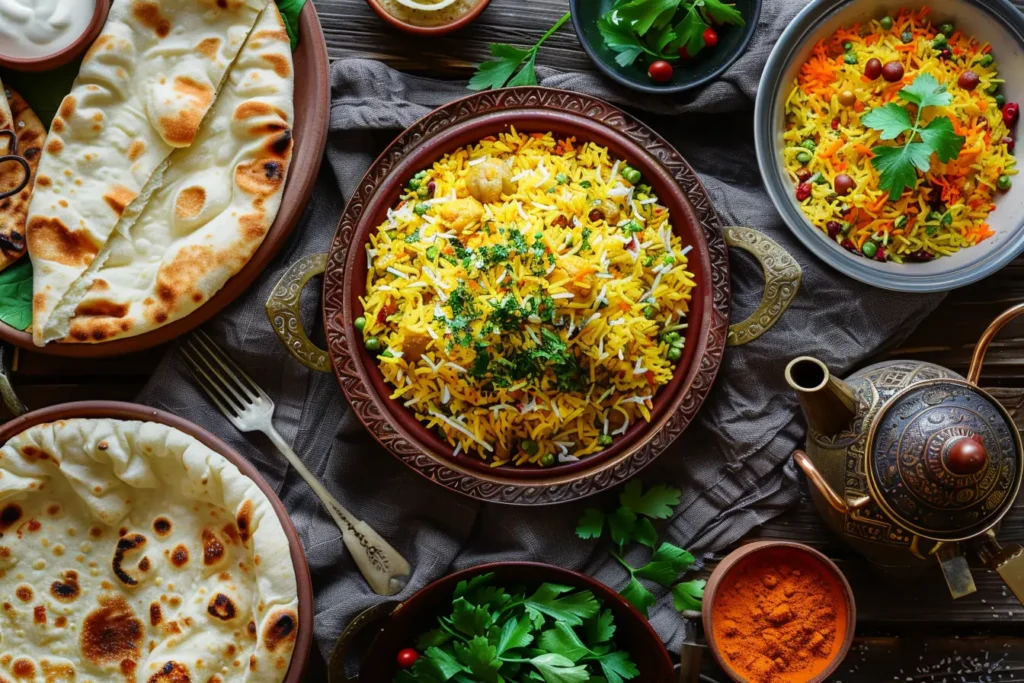
Nowruz, the Persian recipes New Year, is more than just a holiday—it’s a celebration of renewal, spring, and family. As such, food plays a central role, with symbolic Persian recipes that honor tradition, abundance, and hope for the year ahead.
These dishes are prepared with meaning, color, and care, bringing generations together around the table.
Sabzi Polo ba Mahi (Herb Rice with Fish)
- The most iconic Nowruz dish
- Basmati rice mixed with fresh dill, parsley, cilantro, and fenugreek
- Served with fried or grilled white fish, usually mahi sefid
- Symbolizes rebirth, growth, and abundance
Kuku Sabzi (Herb Frittata)
- A vibrant green frittata filled with herbs, leeks, and sometimes walnuts
- Served during Nowruz breakfast or as a side dish
- Symbolizes renewal and fertility due to its deep green color
- Can be made vegetarian or vegan
Reshteh Polo (Noodle Rice)
- Fragrant rice with toasted noodles, caramelized onions, and sometimes meatballs
- Noodles symbolize paths and fate—a wish for success in the coming year
- Often served on Chaharshanbe Suri (last Wednesday before Nowruz)
Samanu (Sweet Wheat Pudding)
- Made from germinated wheat, slowly simmered until thick and sweet
- Served on the Haft-Seen table as a symbol of power, patience, and fertility
- Requires time and love to make, often prepared communally
Ajil-e Moshkel Gosha (Trail Mix of Good Fortune)
- A mix of nuts, raisins, dried figs, and apricots
- Eaten on Nowruz Eve while making wishes
- Each ingredient has a symbolic meaning—health, joy, longevity
Shole Zard (Saffron Rice Pudding)
- Served at gatherings and on Nowruz day itself
- Symbolizes joy and light, thanks to its golden saffron hue
- Often decorated with cinnamon designs and pistachios
Nowruz isn’t just about delicious Persian recipes—it’s about what those dishes represent: life, hope, and unity. Preparing them is a ritual of renewal, welcoming spring with flavor and symbolism.
To understand more about how food plays a central role in Persian culture and traditions, you can explore this insightful article by The British Museum on Persian Food and Identity.
Frequently Asked Questions about Persian Recipes ❓
What is the most popular Persian dish?
Among the many beloved Persian recipes, Ghormeh Sabzi often holds the top spot. This herb stew, made with kidney beans, lamb, and dried limes, is deeply flavorful and considered a national favorite.
Is Persian food healthy?
Yes, Persian cuisine is naturally balanced. It includes lots of fresh herbs, legumes, vegetables, and lean proteins. Many dishes are gluten-free, and meals are typically cooked with olive oil or ghee, avoiding heavy frying.
What makes Persian rice different?
Persian rice is known for its unique texture and aroma. The two defining features are:
Tahdig — the crispy, golden crust at the bottom
Dam pokhtan — the gentle steaming method that makes each grain fluffy and separate
How do I make perfect tahdig?
To master tahdig:
Parboil the rice, then layer it with oil, yogurt, or bread
Cook it on low heat for at least 30–45 minutes
Do not lift the lid until it’s done—the steam is key
What are common spices used in Persian cooking?
Essential Persian spices include:
Saffron (for color and aroma)
Turmeric (base for stews)
Cinnamon, cardamom, and clove for sweets and rice
Dried lime for sourness in stews
Can Persian recipes be made vegetarian?
Absolutely. Many traditional dishes are already plant-based, like:
Ash Reshteh
Kuku Sabzi
Dolmeh
Others can be easily adapted using lentils, mushrooms, or plant-based yogurt.
What dessert is common at Persian weddings?
Baghlava, Persian Love Cake, and rice cookies (nan-e berenji) are wedding staples. They symbolize sweetness and prosperity in married life.
What do Iranians eat for breakfast?
A typical Persian breakfast includes:
Barbari bread or sangak
Feta cheese, walnuts, and fresh herbs
Sometimes honey, butter, or a light egg dish like kuku
How is Persian cuisine different from Arabic or Turkish food?
While there are overlaps in ingredients, Persian food places stronger emphasis on:
Herbs over spices
Sour elements like dried lime or pomegranate
Unique rice cooking techniques (like tahdig)
Signature flavors like rosewater and saffron
This FAQ section gives readers clarity and confidence to explore Persian recipes, whether they’re cooking their first ghormeh sabzi or experimenting with sholeh zard.
Final Thoughts and Tips for Beginners 📝
Exploring Persian recipes is more than just cooking—it’s stepping into a tradition of hospitality, celebration, and artful simplicity. Whether you’re an experienced home cook or a total beginner, Persian recipes cuisine welcomes you with open arms, saffron-scented rice, and a table full of color.
Getting Started: Where to Begin
- Start with simple dishes like Mast o Khiar, Kuku Sabzi, or Adas Polo
- Experiment with a basic chelow rice and practice creating tahdig
- Try a stew like Khoresh Bademjan—easy and satisfying
Pantry Essentials to Keep on Hand
- Basmati rice, yellow split peas, lentils
- Saffron, turmeric, rosewater, dried limes
- Fresh herbs like parsley, cilantro, and dill
- Barberries and pomegranate molasses for sweet-tart flavor
Where to Shop for Ingredients
- Local Middle Eastern or Persian recipes markets
- Online spice retailers for high-quality saffron and rosewater
- Fresh produce markets for herbs and eggplants
Final Cooking Tips
- Be patient—Persian cooking is gentle and slow for a reason
- Taste frequently; balance is everything in these recipes
- Presentation matters: garnish with nuts, herbs, or a dusting of cinnamon
- Invite others—Persian meals are meant to be shared
Every time you prepare a dish like sabzi polo, fesenjan, or ash reshteh, you’re participating in a culinary story that has been passed down for thousands of years. Start where you are, keep your pantry fragrant, and remember: in Persian cuisine, love is the most important ingredient.
If you’re into fusion comfort food too, don’t miss our homemade KFC bowl recipe—another flavorful dish that blends tradition with creativity.
